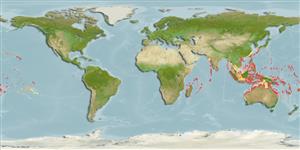Common names from other countries
Environment: milieu / climate zone / depth range / distribution range
экология
морской ассоциированный с рифами; пределы глубины 0 - 36 m (Ref. 1602), usually 1 - 5 m (Ref. 90102). Tropical; 30°N - 32°S, 43°E - 130°W
Indo-Pacific: East Africa to the Hawaiian, Marquesan and Tuamoto islands, north to southern Japan and the Ogasawara Islands, south to New South Wales (Australia) and Lord Howe Island.
Size / Вес / Возраст
Maturity: Lm ? range ? - ? cm
Max length : 13.0 cm TL самец/пол неопределен; (Ref. 9710)
колючие лучи спинного плавника (общее число) : 13 - 14; членистые (мягкие) лучи спинного плавника (общее число) : 20 - 22; колючие лучи анального плавника: 3; членистые (мягкие) лучи анального плавника: 16 - 17.
Common in shallow exposed reef flats, lagoons, and seaward reefs; in relatively open areas with scattered corals and occasionally at depth of 36 m (Ref. 205). Benthopelagic (Ref. 58302). May be solitary or in small groups (Ref. 90102). Usually in pairs. Juveniles often in small aggregations and commonly mix with other similar sized juveniles, especially C. kleinii. Feed on small worms, small benthic invertebrates, coral polyps, and filamentous algae. Oviparous. Form pairs during breeding (Ref. 205). Minimum depth reported taken from Ref. 128797.
Life cycle and mating behavior
Maturities | размножение | Spawnings | Egg(s) | Fecundities | личинки
Distinct pairing (Ref. 205). Monogamous mating is observed as both obligate and social (Ref. 52884).
Myers, R.F., 1991. Micronesian reef fishes. Second Ed. Coral Graphics, Barrigada, Guam. 298 p. (Ref. 1602)
Статус Красного Списка МСОП (Ref. 130435)
CITES (Ref. 128078)
Not Evaluated
Угроза для людей
Harmless
Использование человеком
рыболовство: не имеет хозяйственного значения; аквариум: коммерческий
дополнительная информация
инструменты
Специальные отчеты
Скачать в формате XML
ресурсы в Интернет
Estimates based on models
Preferred temperature (Ref.
115969): 25 - 29.3, mean 28.3 (based on 2407 cells).
Phylogenetic diversity index (Ref.
82804): PD
50 = 0.5000 [Uniqueness, from 0.5 = low to 2.0 = high].
Bayesian length-weight: a=0.02344 (0.01499 - 0.03666), b=2.95 (2.82 - 3.08), in cm Total Length, based on LWR estimates for this species & Genus-body shape (Ref.
93245).
Trophic level (Ref.
69278): 3.5 ±0.3 se; based on diet studies.
устойчивость к внешним воздействиям (Ref.
120179): высокий, минимальное время удвоения популяции до 15 месяцев (Preliminary K or Fecundity.).
Fishing Vulnerability (Ref.
59153): Low vulnerability (10 of 100).
